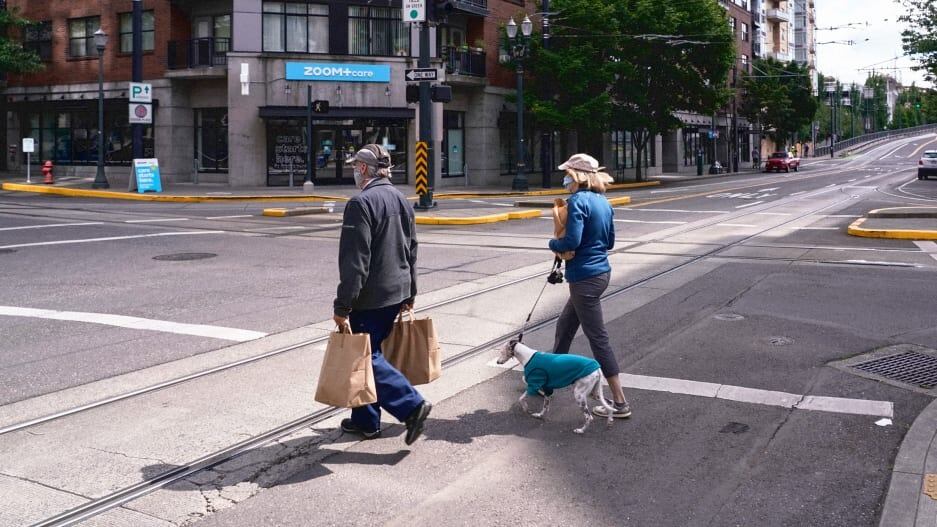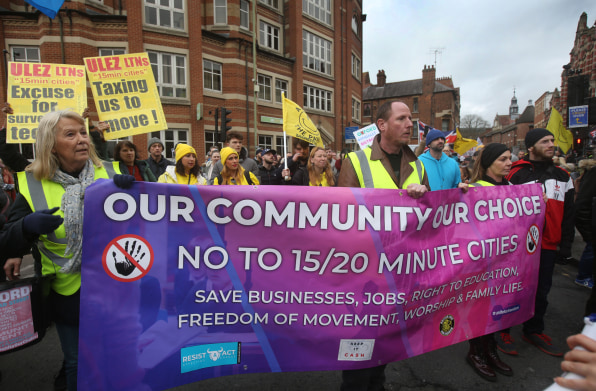- | 9:30 am
The case for 15-minute cities
The concept of a city where all essentials are 15 minutes away by foot or bike has come under fire from conspiracy theorists recently. But it’s just how people in cities used to live.

At my last apartment in Oakland, it took five minutes to walk to the local library or a coffeeshop, or to get a burrito or dumplings or Nepalese food. I was a few blocks from a dentist, a hardware store, a shoe repair shop, two bookstores, and four grocery stores; a few blocks further, I could go to a movie or get on a train to go see a show downtown or in San Francisco. A park with a hiking trail around a large reservoir was a 10-minute bike ride away. It was easy to drive, but I just didn’t have to.
The basic concept of the “15-minute city”—the idea that ideally, cities would be designed so that anyone can reach everyday destinations within a short walk or bike ride—isn’t new. In Paris, where Mayor Anne Hidalgo helped popularize the idea in a reelection campaign in 2020, some parts of the city were already walkable enough to meet the “15-minute” definition. In the U.S., your great-grandparents might have lived in a neighborhood like this, and fragments still exist.
“I think you can look at most urban development that happened prewar, pre-mass expansion of personal automobile use, and you can see examples of that,” says urban designer Mallory Baches, director of strategic development at the nonprofit Congress for the New Urbanism. (It doesn’t necessarily have to happen in a city: if you live in a small town, you might also be able to quickly walk or bike to a grocery store, work or school, and other daily errands.)
Some urban planners have been pushing for more walkability for decades. But the catchiness of the 15-minute-city concept has gained traction in recent years, both as a way to reduce pollution from cars and to increase quality of life. (Other cities, such as Portland, Oregon, pushed for “20-minute neighborhoods” earlier.) Last year, Cleveland started to adopt a 15-minute city framework for planning. The small city of O’Fallon, Illinois, worked the idea of the 15-minute city into its master plan for 2040, with more density, mixed-use neighborhoods, and a better network of sidewalks and bike paths. But as more cities have started talking about it, it’s also spawned a backlash.

In the U.K., Conservative politician Nick Fletcher called 15-minute cities an “international socialist concept” that would “take away your personal freedoms.” Conspiracy theorists claim that residents of the city of Oxford—which has plans to both adopt 15-minute city ideas and, separately, reduce the traffic on some roads—would be trapped in their own neighborhoods. Last month, 2,000 demonstrators gathered in Oxford with signs like “Say no to 15-minute cities” and “Zero carbon means zero life.” Conservative commentator Jordan Peterson said that the idea was “just another fad hijacked by wannabe authoritarians.”
In reality, the idea offers more freedom, not less: If you want to run an errand without sitting in traffic, you can. The vision suggests that more people also would have the option to walk or bike to work, or work remotely, so that they could avoid commuting in a car. “What it means is as an individual, you aren’t relegated to your automobile,” says Baches.
There are multiple benefits. Less time spent driving or searching for parking means more free time to do things you actually enjoy (in studies, people rank commuting as one of their least favorite activities, unsurprisingly). For every 2,000 steps you walk, your risk of premature death may fall 8% to 11%, according to one recent study. Your risk of diabetes or heart disease drops. Walking reduces stress and makes you happier; another study found that if you have an hour-long commute, you’d need to earn 40% more to be as happy as someone who can walk to work. You’re more likely to know your neighbors. The list goes on.
As the name “15-minute city” suggests, the concept isn’t just about a particular neighborhood, but giving people across a city better access to daily amenities. Fifteen-minute zones stretch farther than single neighborhoods and overlap, and if someone wants to go to another part of the city, they obviously can.
Still, even without conspiracy theories warning of being locked down in a neighborhood, people balk at the idea of changes in infrastructure that could make walking and biking easier. Even in liberal Berkeley, California, for example, a planned bike lane has generated fierce resistance from residents who are afraid of losing parking spaces.
“We’ve come to assume, as a general public, that the way that you get to your work, to your school, to your job, to your shopping, to your appointments—that you do that by car,” says Baches. But people forget, she says, that top-down planning created that car dependency, including zoning that keeps housing far from stores, or wide streets with fast traffic and little shade that few people want to walk on. It’s not so much that people choose to drive, as they’ve been forced into it by bad design.
Whether or not the “15-minute city” catchphrase continues, the idea will, Baches says. “I think that the ideas that the 15-minute city describes are the future of cities,” she says.








































